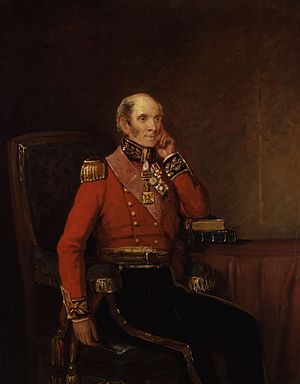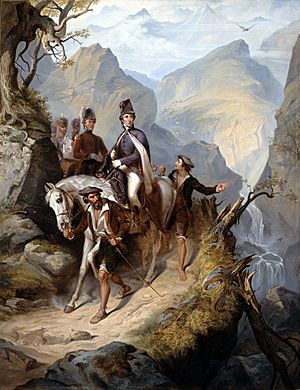John Byng, 1st Earl of Strafford facts for kids
Quick facts for kids
The Earl of Strafford
|
|
|---|---|

Portrait of John Byng by William Salter, 1834–1840
|
|
| Born | 1772 Berkeley Square, London |
| Died | 3 June 1860 (aged 87 or 88) Grosvenor Square, London |
| Allegiance | |
| Service/ |
|
| Years of service | 1793–1831 |
| Rank | Field Marshal |
| Commands held | Grenadier Bn 3rd Regiment of Foot Guards 2nd Guards Brigade Northern District Commander-in-Chief, Ireland |
| Battles/wars | French Revolutionary Wars Irish Rebellion of 1798 Napoleonic Wars |
| Awards | Knight Grand Cross of the Order of the Bath Knight Grand Cross of the Royal Guelphic Order |
Field Marshal John Byng, 1st Earl of Strafford (1772 – 3 June 1860) was an important British Army officer and a politician. He started his military career as a junior officer during the French Revolutionary Wars and the Irish Rebellion of 1798.
Later, he became the leader of the Grenadier Battalion of the 3rd Regiment of Foot Guards during the difficult Walcheren Campaign. He also commanded a brigade at the Battle of Vitoria and the Battle of Roncesvalles in 1813. At Roncesvalles, his brigade bravely faced a strong French attack for three hours.
During the Hundred Days (a period when Napoleon returned to power), he led the 2nd Guards Brigade at the Battle of Quatre Bras and the famous Battle of Waterloo in June 1815. His troops played a key role in defending Château d'Hougoumont at Waterloo. After his military service, he became Commander-in-Chief, Ireland. He was also elected as a Whig Member of Parliament for Poole. He was one of the few military leaders who supported the Reform Bill, which brought big changes to voting rights in Britain. For this, he was given a special title, known as a peerage.
Contents
Early Life and Family
John Byng was born in 1772. He was the third son of George Byng (1735–1789). His family lived at Wrotham Park in Middlesex, which is now part of Hertfordshire. His great-grandfather was a famous naval officer, Admiral George Byng, 1st Viscount Torrington (1663–1733).
John Byng went to school at Westminster School.
Military Career
First Steps as an Officer
John Byng started his military career on 30 September 1793. He became an ensign in the 33rd Regiment of Foot. He quickly moved up the ranks, becoming a lieutenant in December 1793 and a captain in December 1794.
He was sent to the Netherlands in 1795, where he was injured during a small fight. In 1796, Byng worked as an aide-de-camp (a personal assistant to a senior officer) in Ireland. He was wounded again during the Irish Rebellion of 1798.
He continued to be promoted, becoming a major in 1799 and a lieutenant-colonel in 1800. In 1804, he joined the 3rd Regiment of Foot Guards. He took part in military expeditions to Hanover in 1805 and the Battle of Copenhagen in 1807. He also commanded his regiment's Grenadier Battalion during the challenging Walcheren Campaign in 1809.
Fighting in the Napoleonic Wars
Byng was promoted to colonel in 1810. In 1811, he went to Spain to command a brigade under General Rowland Hill. He became a major-general in 1813.
He led his brigade at the Battle of Vitoria in June 1813. Then, on 25 July 1813, he fought at the Battle of Roncesvalles. His brigade faced the main French attack and held their ground for three hours. This brave stand allowed the Marquess of Wellington (who later became the Duke of Wellington) to gather enough troops. This helped Wellington defeat the French in the Battle of the Pyrenees a few days later.
Bravery at the Nive
Byng also fought at the Battle of Nivelle in November 1813 and the Battle of the Nive in December 1813. At the Battle of the Nive, he led his soldiers up a hill while under enemy fire. They captured the hill and planted the flag of the 31st Regiment of Foot there. Then, they pushed the French troops back down the hill.
His bravery was so impressive that the Prince Regent (who later became King George IV) gave him a special honour. He was allowed to add a picture of the 31st Regiment's flag to his family's coat of arms. He also received a special crest showing an arm holding the flag, with a gold cross hanging from it. This was a royal sign of approval for his outstanding service.
The Battle of Waterloo
Byng continued to fight, taking part in the Battle of Orthez in February 1814 and the Battle of Toulouse in April 1814.
During the Hundred Days in 1815, he commanded the 2nd Guards Brigade. He led them at the Battle of Quatre Bras in June 1815 and then at the famous Battle of Waterloo later that month. At Waterloo, his brigade's light companies were very important in defending Château d'Hougoumont, a key farmhouse on the battlefield.
After Waterloo, Byng was put in charge of the I Corps. He helped advance on Paris and captured the town of Péronne and its fortress. His troops then occupied the heights of Montmartre and became part of the Army of Occupation. For his service, he received several awards, including being made a Knight Commander of the Order of the Bath.
Life in Ireland and Politics

In October 1815, Byng became the General Officer Commanding the Eastern District in England. He then moved to lead the Northern District in England in June 1816.
During his time in the Northern District, a large protest happened in Manchester in 1819, known as the Peterloo Massacre. Byng was not present that day, as he was at horse races. He had given command to his deputy. Sadly, the attempt to peacefully break up the crowd failed, leading to 18 deaths and many injuries.
Byng was promoted to lieutenant general in 1825 and became a Knight Grand Cross of the Order of the Bath in 1828. He then became Commander-in-Chief, Ireland and joined the Privy Council of Ireland.
After leaving Ireland, he was elected as a Whig Member of Parliament for Poole in Dorset in October 1831. He was one of the few military men who supported the Reform Bill of 1832. This bill was very important because it changed who could vote in Britain.
Because of his support for the Reform Bill, the Prime Minister, Lord Melbourne, gave him a special title. On 8 May 1835, he became Baron Strafford of Harmondsworth. This title connected him to his mother's family, who had held the Earldom of Strafford before. He was also made the honorary Governor of Londonderry and Culmore in 1832.
He continued to rise in rank, becoming a full general in 1841. In 1847, he received even higher titles: Viscount Enfield and Earl of Strafford. Also in 1847, he inherited Wrotham Park after his older brother passed away.
In his later years, Byng served as an honorary colonel for several regiments, including the Coldstream Guards. He was promoted to field marshal on 2 October 1855. John Byng passed away at his home in Grosvenor Square in London on 3 June 1860.
Family Life
John Byng was married twice:
- His first wife was Mary Mackenzie, whom he married in 1804. They had one son:
- George Stevens Byng, 2nd Earl of Strafford (1806–1886), who inherited his father's titles.
- After Mary's death, he married Marianne James. They had another son and three daughters.


